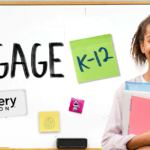What happens when school policies and practices unintentionally eradicate students’ language from their linguistic repertoires?
By Beatriz Maldonado
Originally published in the March/April 2020 issue of AC&E
Public schools in the United States are required to abide by the Bilingual Education Act of 1968
In simplistic terms, the Bilingual Act asks school districts to address the needs of “limited English-speaking” children. While the Act asks districts to provide linguistic support and academic instruction to children who speak a language other than English, the fact that it refers to them as “limited” carries a deficit mindset.
The deficit mindset allows districts to design and implement programs for children who speak languages other than English. In some instances, children will learn only English in the program. In other settings, they will learn English and academic subjects in their native language until a certain point of their educational careers (usually up to 3rd grade) and then they will transition to only English instruction. There are a plethora of other types of programs all with the end result of learning English (e.g. developmental bilingual, transitional bilingual, English as a Second Language, English pull-out, or content English).
What the Act doesn’t describe is that children will learn English at the expense of losing their native language
English will eventually replace their native language in schools. In some cases, children completely forget their native language and in others, their native language grows stagnant. Even when children are enrolled in bilingual programs these programs don’t have a goal of helping children become truly bilingual. On the contrary, they are designed to move children to English as quickly as possible. Ultimately, this results in the eradication of children’s native language.
Children enrolled in these types of program often feel like their native language isn’t valued and is seen as deficit. Another consequence of these programs, is that children are encouraged to assimilate to the mainstream culture as soon as possible with little regard for their own cultural assets. What happens when we intentionally implement policies and practices that honor student’s linguistic abilities while supporting them to acquire another language?
There is an equity movement taking place across the country
It has resulted in school districts rethinking how they educate emergent bilingual students. Contrary to implementing subtractive programs, previously described, districts have elected to implement additive programs that “add” a language to students’ already existing linguistic repertoires. Such programs are called: one-way or two-way dual language, developmental bilingual, heritage language, or foreign language immersion.
While the linguistic background of each of these students varies, the uniting factor in each type of program is that they are valuing and maintaining the students’ native language while also adding another language to their linguistic repertoire.
Districts across Illinois are debunking the myths that children learning two or more languages early on get confused. On the contrary, children in dual language classrooms are engaging in complex contrastive analysis of the similarities and differences between the two languages as early as kindergarten.
For example, in a recent classroom visit, I witnessed children in a kindergarten classroom discussing the similarities and differences in the use of articles in Spanish and English nouns. They said, “en Español usamos la pero en ingles, usamos the enfrente de un sustantivo” (in Spanish we use la but in English, we use the in front of a noun). They went on to identify cognates (i.e. words sharing similar meaning, spelling, and pronunciation in two languages) in the unit that they were learning about (ex. doctor/doctor, comparar/compare).
As children move up in grades, children begin to engage in more complex contrastive analysis of language. They start looking at syntax, grammar, and pragmatics.
Complex conversations such as these could not take place in monolingual only classrooms because one requires the use of both languages. Additionally, the cognitive demand that’s required in these conversations allows children to think critically and to analyze language by drawing on their own linguistic abilities.
Another benefit of implementing additive programming such as dual language, is that children are grouped with other children who come from varying language and cultural backgrounds. In the district that I work in, there are children whose home language is English, Spanish, French, or Vietnamese. In the program, children are able to maintain their home language (because it’s spoken at home) and learn a second or in some cases a third language while at school.
Children see their language abilities as assets that they can draw upon
Their self-esteem is preserved because they don’t have to be embarrassed when speaking their home language. Children in the program learn about each other’s backgrounds, cultures, and celebrations. They learn to appreciate the differences that each one of them brings to the classroom and they begin to ask questions about these in an environment that values who they are as individuals and as a community of learners.
As I think of subtractive programs, programs that have been implemented across the country for many years, I think of educational malpractice. What if we knew that these programs didn’t work? Fortunately, we know that they don’t work. One needs only to look at the research of Thomas and Collier (2009, 2012, 2013) to see the long term effects of each type of program. Continuing to implement such programs results in professional negligence – a practice that needs to stop if we believe that children from diverse linguistic backgrounds deserve adequate schooling.
Dual language programs on the other hand, strive for linguistic equity
These programs try to equalize the playing field for children who speak a language other than English by removing barriers that impede their academic progress. By having educators implement these programs, they are removing the negative effects of subtractive schooling and begin to see children’s linguistic abilities as assets. It’s up to teachers, school administrators, and district administrators to develop policies that support additive programming while eradicating policies that engage in educational malpractice.
Beatriz Maldonado is serving as the Director of Language Acquisition in Berwyn South School District. She has served in the role of bilingual teacher, Assistant Principal, Principal, and Parent Engagement Director. Recently she served as a Board Member of the Illinois Association of Latino Administrators and Superintendents (IALAS). Currently serves as an Adjunct Professor in the School of Education at Dominican University.
The American Consortium for Equity in Education, publisher of the "Equity & Access" journal, celebrates and connects the educators, associations, community partners and industry leaders who are working to solve problems and create a more equitable environment for historically underserved pre K-12 students throughout the United States.
- American Consortium for Equity in Educationhttps://ace-ed.org/author/admin/
- American Consortium for Equity in Educationhttps://ace-ed.org/author/admin/April 23, 2025
- American Consortium for Equity in Educationhttps://ace-ed.org/author/admin/
- American Consortium for Equity in Educationhttps://ace-ed.org/author/admin/







